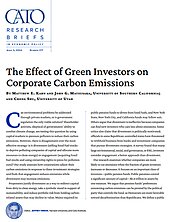Can environmental problems be addressed through private markets, or is government regulation the only viable solution? Shareholder activists, skeptical of governments’ ability to combat climate change, are testing this question by using capital markets to pressure polluters to reduce their carbon emissions. However, there is disagreement over the most effective strategy: is it divestment (selling fossil fuel stocks to deprive polluting companies of capital and allocate more resources to clean energy) or engagement (acquiring fossil fuel stocks and using ownership rights to press for pollution cuts)? Our study assesses how corporations adjust their carbon emissions in response to these investment strategies and finds that engagement reduces emissions while divestment may increase emissions.
Proponents justify divestment as a way to redirect capital from dirty to clean energy, take a symbolic stand in support of sustainability, and reduce portfolio risk from holding carbon-related assets that may decline in value. Maine required its public pension funds to divest from fossil fuels, and New York State, New York City, and California funds may follow suit. Others argue that divestment is ineffective because companies can find new investors who care less about emissions. Some critics also claim that divestment is politically motivated; officials in some Republican-controlled states have threatened to withhold business from banks and investment companies that pursue divestment strategies. A survey found that many large environmental, social, and governance, or ESG, investors consider engagement a better approach than divestment.
Our research examines whether companies are more likely to cut emissions when the fraction of green investors increases or decreases. It focuses on an important class of investors—public pension funds. Public pensions control a significant amount of capital—$5.6 trillion in assets by one measure. We argue that pension funds’ preferences concerning carbon emissions can be proxied by the political party that controls the fund, as Democrats are more favorable toward decarbonization than Republicans. We define a public pension fund as green in two ways: first, based on the partisan composition of a fund’s board of trustees, and second, based on the governor’s party affiliation (because governors can influence pension fund investment by appointing trustees and taking legislative and regulatory actions).
One cannot obtain the true causal effect of changes in the fraction of green investors on emissions by looking only at the market decisions of green investors. These investors may buy or sell assets based on preexisting trends in companies’ emissions, but we want to identify changes in emissions that result from green investors’ purchase or sale of assets. We addressed this issue by relying on two sources of variation in shares held by green investors that are arguably unrelated to company emissions. The first stems from shifts in political control in a state. Changes in the party of the governor and pension trustees are driven by a state’s political dynamics and are not connected to emissions changes at companies held by their public pension funds. The second source of variation comes from the fact that public pension funds typically maintain target ratios for their investment in public equities relative to other asset classes, such as private equity, real estate, and commodities. If the non-public-equities part of a fund’s portfolio increases in value, the fund must acquire more public equities to restore its target ratio. This rebalancing is also unrelated to emissions.
Our key finding is that an increase in the fraction of shares held by green public pension funds caused companies to reduce their carbon emissions during the period 2010–2021. Specifically, a 1 percentage point increase in a company’s shares held by green pension funds was associated with an approximately 3 percent reduction in plant emissions over four years. In contrast, ownership by nongreen public pension funds is associated with increases in corporate carbon emissions, though we cannot rule out the possibility that these results occurred by chance. These patterns hold when we consider the party of the governor in a facility’s state to account for direct policy effects on emissions. In short, engagement reduced emissions; divestment did not. These findings suggest that divestment strategies are likely to be counterproductive, resulting in increased emissions compared with holding the stock.
We also investigated three reasons why green investor ownership of a company’s stock might lead to emissions cuts. First, ownership might cause corporate managers to alter company policies to please shareholders. Second, ownership might allow investors to engage management through adversarial means, such as voting against incumbent directors and sponsoring shareholder proposals. Third, investors may engage management through collaboration and persuasion by expressing preferences and sharing knowledge. The evidence is largely suggestive rather than definitive but points to a primary role for engagement, probably involving both adversarial and persuasive means. Our research finds that emissions reductions were more strongly associated with ownership by pensions known for actively engaging management rather than by passive funds. Active green funds were more likely to vote against director nominees and to support shareholder proposals, but the effect sizes were modest. Additionally, our research finds no evidence that green investors lead to more environmental shareholder proposals.
Finally, we explored how companies achieved emissions reductions. Our results show that companies primarily cut output; among plants that generated electricity, reductions in electricity output tracked emissions reductions almost one-to-one on average. Our results offer no evidence that companies with green investors increased the number of patents they filed related to green technology. Lastly, there is little evidence that companies with green investors were more likely to divest their high-emissions facilities, so-called greenwashing. The companies that we studied cut their emissions mainly by reducing the amount of power produced in their dirtiest facilities.
NOTE
This research brief is based on Matthew E. Kahn, John G. Matsusaka, and Chong Shu, “Divestment and Engagement: The Effect of Green Investors on Corporate Carbon Emissions,” National Bureau of Economic Research Working Paper no. 31791, January 2024.

This work is licensed under a Creative Commons Attribution-NonCommercial-ShareAlike 4.0 International License.
